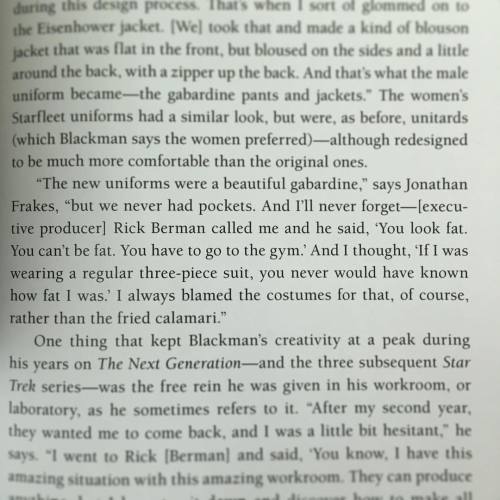
#Frakes
CATS
let’s talk about housecats and how fucking weird they are evolutionarily/anthropologically
like who thought it was a good idea to have tiny malicious predators in our homes anyways????? (not us actually)
are they even domesticated????!!!?? (yes) do they even feel LOVE???????!!? (yes)
LET’S LEARN ABOUT CATS
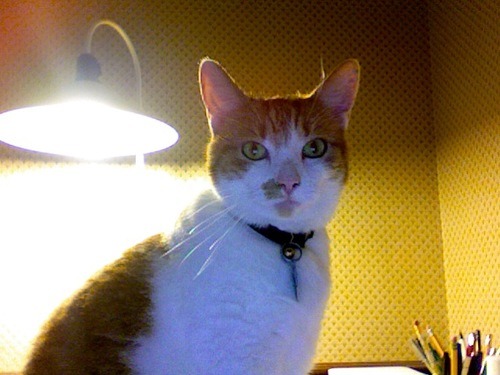
“you ready 2 learn punk”
PART ONE: WHAT CIRCLE OF HELL DID CATS EVEN COME FROM
Housecats are the most popular pet in the world, and there are about 600 million of them on earth (compare that to the 525 million dogs!)
Cats are the first of only two solitary predators EVER to be domesticated, and the second was ferrets about 2,000 years ago.
Nobody is sure when cats were actually domesticated, mainly because fossils tell one story and genes tell another. Archaeologists say cats were domesticated by the Egyptians ~3,500 years ago.
I’m firmly in the molecular evidence camp myself, which says cats were probably domesticated around 10,000 years ago when humans first figured out how to farm and store crops. What do you get when you store lots of grain?

hello friend i heard you had some tasty nibblies i’ll just let myself in
SO MANY LITTLE RATTIES AND MOUSIES CAME TO PLAY. I don’t know if you’ve ever seen footage of a mouse plague (DO NOT CLICK IF SQUEAMISH ABOUT RODENTS) but it is what happens when you put a lot of mouse food in one place and there is no one to eat them.
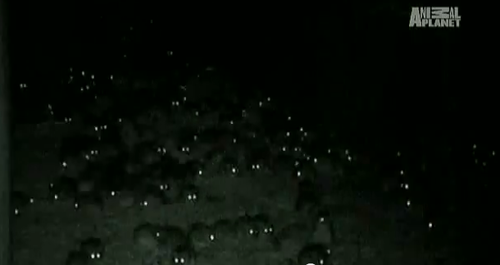
the floor is mice i repeat the floor is mice
But luckily that didn’t happen in this case, because way back then in the fertile crescent (cradle of human civilization baby) there actually was a very, very good predator of little squeaky things. A wild predator. A savage, untamable hunter. This guy.
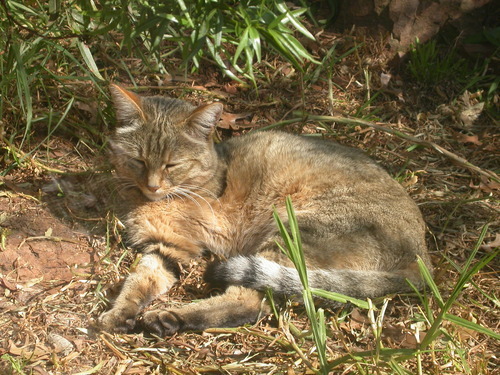
the most feared hunter in all the land
“Okay Koryos,” you say, furrowing your sweaty, vaguely mottled brow, “that’s a cute picture of a sleepy domestic kitty, but where’s the terrifying feral ancestor?”
I’m not joking. That picture up there is a wild animal, Felis sylvestris. Maybe it will become more apparent if I can get her to open her mouth.

“i am completely different animal from a housecat my canines are slightly longerrrrrrr!”
Ah yes, the wildcat. Specifically, the African wildcat, as that would have been the subspecies roaming around the fertile crescent at the time. In total, there are three major physical changes the African wildcat went through on its way to becoming domesticated:
Aside from that, and the proliferation of piebald coloration (as it is in most domestic animals- there is actually probably a genetic link between piebaldness and domestic behavior- but we’re getting ahead of ourselves here) there is really not much of a difference in the appearance of the African wildcat and your average domestic tabby. Naturally, they can interbreed magnificently well.
Of course, this raises the question: why is the number of African wildcats constrained to 10,000 in Africa and still shrinking, where domestic cats are 600 million strong and have visited every continent? And I do mean every continent.
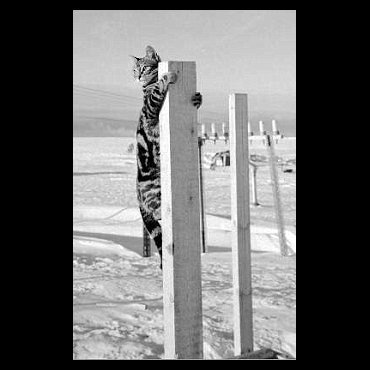
Pictured: a cat chilling outside a naval base in Antarctica.
If you said the obvious answer was human intervention, you would be correct… kinda.
PART TWO: CATS USE US TO THEIR ADVANTAGE
We all know the stereotype that dogs are happy loving doofs while cats are ~independent assholes~, right?
Anyone who has spent a prolonged amount of time around my cat will know how blatantly untrue this is, as you have not met a needy animal until you have sat with one trying to literally wrap her paws around your neck so you can’t leave- uh, I digress.
There’s a very similar saying among researchers that dogs were domesticated, but cats domesticated themselves.
While not strictly true in terms of dogs (oh, I can go off on dog domestication do not get me started) this is pretty much on the money for cats. Humans didn’t grab cats and make them start hunting mice. In fact, that would be incredibly difficult, as wildcats are extremely shy. Cats simply heard the rodents squeaking around in whatever the ancient version of a silo was and went after them. And the humans certainly had no reason to discourage them (once they figured out what was going on, I presume- I imagine the first human opening a door and spotting a cat inside shrieking “THE MICE HAVE GROWN HUGE SAVE YOURSELF”)
Flight distance refers to the distance an animal is willing to let you approach it before it flees. African wildcats today have a pretty massive flight distance- you are extremely lucky if you see one before it spots you and jets. Those first cats attacking the mice in human granaries would have had a big disadvantage if they were running every time they spotted a human within thirty feet. So, they adapted. Their flight distance shrank from generation until eventually they were able to tolerate humans within feet of them. Think of the behavior of squirrels in suburban areas. They aren’t going to let you pick them up, exactly… but they’re definitely not afraid of you.
For the fact that my cat aggressively demands my cuddles every night, we can probably thank the ancient Egyptians. Egyptians were a little cat obsessed. And by a little, I mean that there are burial grounds where mummified cat remains are so densely packed that the soil you are walking on is 98% powdered cat. Nasty.
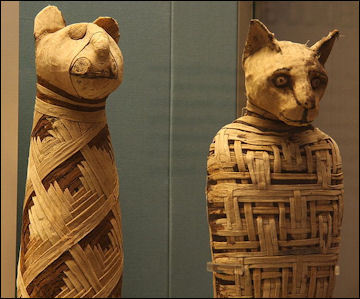
note: do not search ‘cat mummy’ in google images because some results will distress you deeply
In Egyptian hieroglyphs and imagery we see the first instances of the cat acting like a pet. Cats sitting under chairs, cats being played with, and of course, cats being petted! There is even evidence that cats were trained and used to scare game up for hunters, much like some breeds of dogs are today.

Image from the tomb of Nebamun. Either a cat scaring up game or a cat just having the best afterlife ever. full of murder.
This new closeness would only be possible if the Egyptians had started taking kittens from semi-domesticated cats and raising them to become accustomed to human contact. Thus, cats underwent the final stages of their domestication. And boy were there a fucking lot of them, and boy did the Egyptians love them. Look up the cult of Bastet if you’re interested in all that- I only do animals ok I don’t fuck around with human history ok
(Or ask my history friends, elizabeth-karenina and stormeagle. They are friendly and physically attractive. i am not biased)
Anyway these were the first true cat colonies, the kind you can imagine living in urban areas today, living in and around the Egyptian temples. This was a pretty big deal, considering the fact that the African wildcat is a solitary animal that doesn’t tolerate other individuals living in their territories. And now we have colonies of cats of up to 200 living shoulder to shoulder.
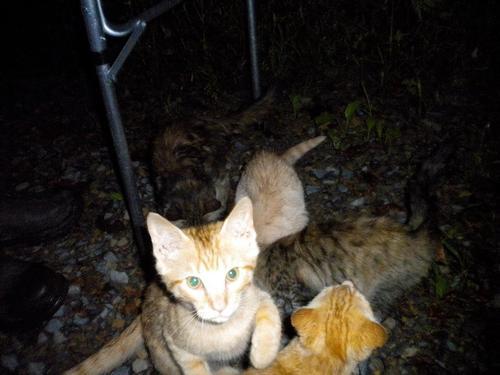
note to my readers if you are studying bats late at night and you notice a few cats do not bring chicken the next night do not do it they can smell it and THE HORDE WILL COME
THIS IS ACTUALLY A BIG DEAL because it is a complete reversal of behavior like if you look at the domesticated dog the wolf was already social as an adult??? but wildcats were not AND they were very shy/aggressive to others??? WOW WHAT HAPPENED
PART THREE: THE MIRACLE HAPPEN
Alright so we get a lot of people basically saying, hey, cats are not domesticated because a) they live very well in feral colonies without human support and b) they still have a sensitive period as kittens in which they need to be handled by humans or else they will become shy as fuck as adults.
THIS OF COURSE DEPENDS ON YOUR DEFINITION OF DOMESTICATION. There are in fact several and the one I subscribe to is p. different but anyway let’s go with this one for now (that domestic animals can’t live without human help/are altered from birth to be accepting of human contact).
FiRST of all every species of domestic animal still has a sensitive period and in fact so do human infants so the reasoning behind that one is a little silly. However it is a very good point that the cat’s sensitive period is pretty extreme compared to other pets’ (like dogs) and a cat that has never been socialized is basically never going to be comfortable around humans even if brought into a home.
The reason for this is probably because the feral and domestic cat populations still interbreed freely so that sensitive period stuck around. If you’re wild you don’t want to be fuckin friendly goin up to every schmuck that crosses your path- you better learn what doesn’t maul you as a kitten and then stick with as an adult, ya dig? Domestication is p. fuckin dangerous in the wild.
Okay but on the subject of the “wildness” of cat colonies, that’s also pretty untrue too. Most cat colonies are SUPPORTED with human help, either by dumpsters or scraps or very often well-meaning human feeders. In rural areas there is not enough food to support huge colonies and cats tend to actually be spread out into single territories like wildcats are. And they also tend to be more malnourished the further they are from human contact. And then they eventually can’t support a growing population. So, there’s that.
So the idea that cats aren’t domesticated seems shaky. So now we go to my preferred definition of domestication- that a) animals are comfortable living in close quarters in large numbers and b) animals are significantly behaviorally changed from wild ancestors to have more prosocial behavior in general (you note that humans aren’t mentioned that’s because animals have actually been known to self-domesticate… for example populations on islands or confined areas. also cats. also humans. whoa)
Alright so some people would contest the second part of that definition- HAVE cats significantly changed their behavior from wild ancestors? The whole colony thing would seem to be pretty conclusive but you can also point out the fact that in captivity, you often CAN get wildcats to tolerate one another pretty well in groups as long as they were raised together. So… has cat behavior changed at all????
ZE ANSWER IS YES OF COURSE but let me segue into that.
Some time ago there was an experiment where researchers tagged both feral cats and wildcats living in the same area in Africa near a city with gps trackers. They found a LARGE difference in behaviors. The feral cats would cluster together around dumpsters for scraps of food at night. The wildcats would NOT and always maintained a large distance away from one another and human habitation. This suggests that regardless of whether or not there is human contact during the sensitive period (this city did not have a culture of keeping cats as pets and the feral cats were treated as pests) feral cats are willing to cluster together- and wildcats, when living their natural lives, are not.
So yes, there is a genetic difference in behavior there that cannot be explained by location/rearing. Mainly of flight distance, which makes a lot of sense. But there are also quite a few other differences too, some of which are surprising. Have a look at these spectrograms of wild and domestic cat meows.
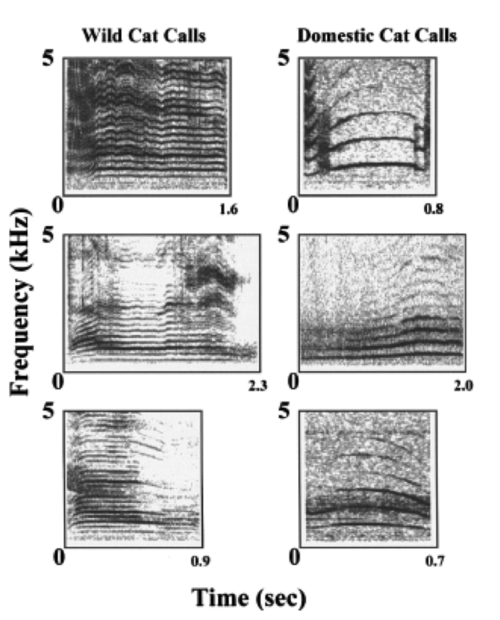
Taken from Nicastro & Owren, 2004. Cited below.
Even if you have no fucking idea what a spectrogram is you can tell that there’s a big difference and that the wildcat meows look a lot denser. Human listers also found them a lot less pleasant to listen to than domestic cat meows, even though they were told that only domestic cat meows were in the study.
There is another big goddamn difference when it comes to meows, too- wildcats will meow as kittens but hardly EVER meow as adults, whereas domestic cats if you hadn’t noticed meow all the goddamn time and never shut up. They have retained the kittenish behavior of meowing into adulthood (similar to the way that dogs retain the wolf puppy behavior of barking into adulthood). This retention of a juvenile trait is known as neoteny and it’s pretty common among domestic animals, particularly pets. You want humans to love you and care for you? BE A BABY FOREVER

this chihuahua has achieved it. literally a baby forever
There is one last slightly horrifying thing about cat meows. Researchers have detected a dissonance in some cries, mainly food-getting ones, that is very similar to another cry- the cry of a human baby. Meaning that over time cat meows have evolved to sound like human babies crying so that we physiologically cannot ignore them.

do u think u will ever be able to sleep in past 6 am again ha ha ha fuck you
What the fuck cats. What the fuck. But those aren’t the only things that have changed. Cause you see, cats, unlike dogs, didn’t have to evolve just to learn how to be around humans. Remember that whole solitary predator thing I keep pushing? They also had to learn, from scratch, how to be around other cats.
PART FOUR: LITERALLY TINY LIONS
The fact that feral cats can sometimes get into very vicious and life-threatening fights with one another is due to the fact that they don’t quite have a whole system of communication worked out the way some other species have. But this does not mean they are not social. Far from it. It’s just that their level of sociability depends on the situation.
For example, researchers doing observational studies have found that male cats behave pretty differently depending on their environment. When they are in rural areas, where cat territories are spread out and females are few and far between, fights between toms get very vicious. But when they are in urban areas, the fights are less frequent and less severe. Sometimes toms will actually wait in line to mate with a queen who’s in heat simply because there’s enough females to go around. No need to fight when there is so much… here it comes you guys… wait for it…. pussy.
[GROAN TRACK]
Female cat sociability is very high in dense colonies as well. Usually mothers, daughters, and sisters will help raise kittens communally. They will nurse one anothers’ kittens and even help each other give birth! WOW. There is usually a dominance hierarchy set up too, usually with the oldest female being on top and her daughters being submissive to her.
“OK but you mentioned lions in the section header and what does this have to do with lions,” you say, aggressively stroking your ridged horns. Well be patient friend I am just getting to that.
I talked earlier a little bit about the retention of one juvenile trait- meowing- into adulthood, aka neoteny. Cats have a lot of other neotonic behaviors, like kneading (aka the thing kittens will do to mom’s belly to stimulate more milk production) and high levels of playfulness (for every cat except my personal cat who hates fun and joy.)
Now, why were these behaviors in particular retained? For wildcats, the only highly social period they experience is when they are kittens living with their siblings and mother. Therefore, these behaviors that exist to communicate with mom, bro, and sis are brought forward when the cats need to be social as adults too. Waste not want not says evolution. All of these behaviors serve to mitigate aggression in some way, so cats can spend less time getting into costly fights.
But juvenile traits aren’t the only ones cats will adapt for social purposes. Ever been rubbed on by a cat? Ever seen a cat be pleased enough to flop down and roll over? Guess where these traits come from? SEX.
Yes that is correct, wildcats use rubbing, headbutting, and rolling to signify to a potential mate that they do not want to fight but rather do the whattup if you know what I mean. It is true that they also use rubbing to scent mark- but when they use it as a social behavior, it is to scent mark that they are going to put their penis in that. Or vice versa.
So at some point submissive domestic cats that did not want to fight started doin this to each other. Like “dude i don’t want to get mauled you are so sexy also can i get your scent on me yeah boi now we friends.”

fuck me you hot hairy bastard. FUCK ME
Okay so this is really cool and all, especially since we don’t see adult wildcats in the wild using these behaviors in this way at all. In fact no cats do, cause cats just aren’t social animals… wait a minute.

DIDN’T I TELL YOU THERE WOULD BE LIONS. look at how happy that one fricker is christ it’s making ME happy
OKAY THE REALLY COOL THING is that lions are in the genus Panthera, right? And alllll the way at the other end of the kitty spectrum is the Felis genus will all the itty cats like domestic cats. Very separated. And yet, lions show many of the exact same social behaviors that domestic cats do.
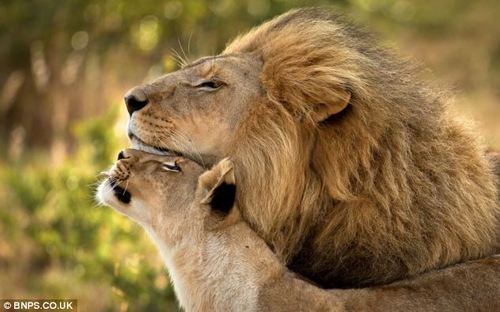
yeah we gon frick. but we are also displaying positive prosocial behavior so we don’t kill each other in the night. and frick instead
Yep, rubbing/headbutting, rolling, vocalizing more (in this case rumbling and roaring instead of meowing), even more playful behavior… lions do these with other members of their pride to maintain social bonds. And these behaviors REAPPEARED in wildcats when they were domesticated. CONVERGENT EVOLUTION. WE HAVE BASICALLY CREATED TINY LION PRIDES. IN OUR LIVING ROOMS. WOW GUYS.
There is actually one social behavior that domestic cats have evolved that lions do NOT have… and neither does any other species of cat on record. Look at this picture of my cat.
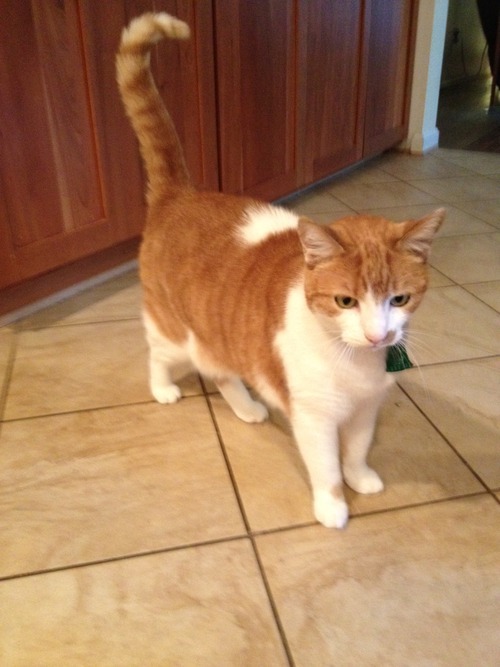
wow what a cutie ugh
How would you feel about this cat approaching you? Pretty good, right?
Now look at this picture.
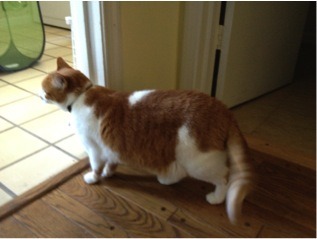
situation has CHANGED note the motion blur
How would you feel about a kitty with this body language approaching you? Now of course there are many subtle differences in body language between the two pictures. But the biggest, most obvious one is the position of the tail.
First picture: tail up. Friendly cat. Will pet. Second picture: tail down and lashing. NOT FRIENDLY DO NOT PET ABORT MISSION
(she was mad at our new washing machine in the second picture btw)
Tail lashing is seen in pretty much every cat species to signify intensity and aggression. But tail up is NOT seen in ANY cat species besides domestic cats, not even lions! Studies have indeed shown that cats are more likely to approach a silhouette with a tail up than one without, suggesting that yes, this is a signal cats use with one another to signify friendliness.
Pretty amazing, right? A completely new, never-before-seen social behavior has evolved in cats!
PART FIVE: SUMMARY, FINALE, GLORY
To sum up what we’ve learned, domestic cats all descended from the African wildcat that was living in the fertile crescent of the Middle East/Africa about 10,000 years ago. They were attracted by the rodent issue that emerged when humans first domesticated grain and wheat species. Cats became really big in ancient Egypt a few thousand years later and started living in big, social colonies.
We can see the effects of these changes in how well (compared to wildcats) the domestic cat can socialize with both humans and other cats! In fact, the social behavior of the domestic cat is very similar to the social behavior of the lion. But there is one behavior, tail up, that seems to be completely new and unique to the domestic cat.
So why study cat behavior at all- why does it even matter what behaviors the cat has or doesn’t have?
Well, as I’ve stressed quite a few times, cats came from a NONSOCIAL species. In the last 10,000 years they have evolved into a completely social species, complete with their own unique signals. That’s pretty amazing. And it shows us the conditions social behavior evolves and reasons why social behavior can be successful. Remember… there are 600 million cats in the world. 10,000 wildcats. 600 million domestic cats.
They played the evolutionary game, and they won. Big time.
SOURCES AND MORE INFORMATION
I plan to study animal behavior and specifically the evolution of social and domestic behaviors for a living, so this is a topic I am obviously passionate about. As ever, I welcome questions, debate, and addendum to this topic! If you enjoyed this post, you might also be interested in another I did on gay and asexual behaviors in animals.
Here are a few quick reads/views to learn more about cat evolution and behavior:
A Brief History of House Cats, an article that appeared in the Smithsonian.
The Science of Cats, a National Geographic Documentary.
a paper written by some pretentious tumblr user, if you want the longer, more professional version of this post. (appendix A, page 41)
And here is a selected bibliography for the science-minded:
Barratt, D. G. (1997). Home range size, habitat utilisation and movement patterns of suburban and farm cats Felis catus. Ecography.
Bradshaw, J., & Cameron-Beaumont, C. (2000). The signalling repertoire of the domestic cat and its undomesticated relatives. The Domestic Cat: The Biology of its Behaviour.
Cafazzo, S., & Natoli, E. (2009). The social function of tail up in the domestic cat (Felis silvestris catus). Behavioural Processes.
Driscoll, C. A. C.-B., Juliet; Kitchener, Andrew C.; O'Brien, Stephen J. (2009). The Evolution of House Cats. Scientific American.
Edwards, C., Heiblum, M., Tejeda, A., & Galindo, F. (2007). Experimental evaluation of attachment behaviors in owned cats. Journal of Veterinary Behavior: Clinical Applications and Research.
McComb, K., Taylor, A. M., Wilson, C., & Charlton, B. D. (2009). The cry embedded within the purr. Current Biology.
Miklósi, Á., Pongrácz, P., Lakatos, G., Topál, J., & Csányi, V. (2005). A Comparative Study of the Use of Visual Communicative Signals in Interactions Between Dogs (Canis familiaris) and Humans and Cats (Felis catus) and Humans. Journal of Comparative Psychology.
Morrison-Scott, T. C. S. (1952). The mummified cats of ancient Egypt.
Nicastro, N. (2004). Perceptual and Acoustic Evidence for Species-Level Differences in Meow Vocalizations by Domestic Cats (Felis catus) and African Wild Cats (Felis silvestris lybica). Journal of Comparative Psychology.
*I meant to talk about proof that cats are attached to their human owners but I forgot and I don’t have a good spot to insert it up there. But uh yeah there is a famous study used with human children to describe good relationships with their mothers, known as attachment. When cats are with their owners, they show the same behaviors that attached human children to with their mothers. Also, some cats have separation anxiety. Owners sometimes alleviate this anxiety by getting another cat to be the first cat’s companion. But this does not alleviate the symptoms of separation anxiety. Why? Because the cat doesn’t want companionship- it wants your companionship and no one else’s.
Your cat loves you. Give her a cuddle today.
Unitcorp Incorporated's mission is focused on our three core pillars of success. By orchestrating broad-based unit paradigms, streamlining customized L-commerce, and e-enabling infometric convergence, Unitcorp has become a worldwide champion in the industry.
Now accepting applications.
"I don’t think it belongs here." Such was the assessment of Bob Vinson, the graveyard shift supervisor at Harvey's Wagon Wheel Casino in Lake Tahoe, Nevada. The "here" Vinson referred to was a nook just outside the telephone equipment room in the employees-only portion of the second floor of the hotel. The "it" was a curious piece of equipment of unknown origin loitering conspicuously in the cramped side room. It was a metallic gray box about the size of a desk, with a smaller box attached on top near the rear right corner. The front face of the smaller box was an incomprehensible control panel occupied by 28 metal toggle switches in five neat rows, each labeled with a numbered sticker. All of these switches were situated in the down position except for #23, which was toggled up—an oddly ominous asymmetry.
It was approximately 6:30am on Tuesday, 26 August 1980, and although Bob Vinson had been on shift all night long, he hadn't heard any large equipment delivery commotion from his nearby office, and he was sure this thing hadn't been there an hour earlier. Whoever had left the machine had taken the time to place each corner on blocks of wood, and these blocks pressed deep dimples into the red-orange carpet, suggesting that the equipment had significant mass. In spite of its resemblance to some kind of manufactured electromechanical office machine, it had no power cord, and no obvious power switch, just the 28 enigmatic toggles. To add alarm to intrigue, Vinson had found that some of the keyholes for the doors leading into the area had been hastily jammed using what appeared to be toothpicks and glue.
An envelope with "Harvey's Management" typewritten on one side lay on the carpet alongside the object. Vinson was reasonably suspicious that the envelope did not contain anything as harmless as an invoice. "Stay here," Vinson instructed the custodian who had been examining the mystery object with him. "Don’t touch it. Don’t let anyone fool with it. I’ll be right back."
Vinson soon returned with companions, having summoned members of Harvey's Wagon Wheel Casino security, who had subsequently summoned sheriff 's deputies and the fire department. After prodding the envelope with a broomstick to ensure it wasn't booby-trapped, those to whom it was concerned gingerly extracted three pages of typed text from the envelope. The letter claimed that this device was a bomb.
STERN WARNING TO THE MANAGEMENT AND BOMB SQUAD:
Do not move or tilt this bomb, because the mechanism controlling the detonators in it will set it off at a movement of less than .01 of the open end Ricter [sic] scale. Don't try to flood or gas the bomb. There is a float switch and an atmospheric pressure switch set at 26.00-33.00. Both are attached to detonators. Do not try to take it apart. The flathead screws are also attached to triggers and as much as 1/4 to 3/4 of a turn will cause an explosion. In other words this bomb is so sensitive that the slightest movement either inside or outside will cause it to explode.
Excerpt from the letter
As 600 or so hotel guests and non-essential staff filed from various vomitoria into the parking lot, having been directed to exit the building due to a "security emergency," members of the sheriff's department bomb squad entered and assessed. The device, whatever it contained on the inside, had been lovingly hand-crafted on the outside. The quarter-inch-thick steel plates composing the boxes had been welded together neatly, and automotive body putty had been employed to smooth dents and seams prior to painting. There were bubble levels mounted to the corners, and threaded feet had been used to level the machine to a perfect horizontal on both relevant axes.

Harvey's c. 1950
Harvey's staff members also alerted Harvey Gross—the casino's owner and namesake—of the strange device and its hostile owner’s manual. Gross was understandably apprehensive that his life’s work was in mortal peril. He had established the casino 36 years earlier, in 1944, as Harvey's Wagon Wheel Saloon & Gambling Hall--a single-room log cabin off Lake Tahoe boasting a trio of slot machines, a pair of card tables, and a wooden wagon wheel nailed to the side of the building. By 1980, Harvey Gross had nurtured his one-time log cabin into a flourishing resort destination, including sprawling rows of slot machines and gaming tables. The wooden wagon wheel was long gone, deposed by a massive neon facsimile. A community of businesses had sprouted in the intervening decades, including a number of competing hotel/casinos, and Harvey’s eleven-story, 197-room hotel tower overlooked the exploits.
This bomb can never be dismantled or disarmed without causing an explosion. Not even by the creator. Only by proper instruction can it be moved to a safe place where it can be deliberately exploded, or where the third automatic timer can be allowed to detonate it. There are three automatic timers each set for three different explosion times. Only if you comply with the instructions in this letter will you be given instructions on how to disconnect the first two automatic timers and how to move the bomb to a place where it can be exploded safely.
Excerpt from the letter
It was not immediately clear whether "the creator" referred to the device's inventor or to some supernatural higher power. Regardless, rather than take the letter at its word, the bomb squad technicians laid out their array of penetrating instruments to probe and catalog the box's exterior and interior. They photographed the box from every angle. They waved a Geiger counter around its vicinity and ensured there was no nuclear material. They dusted the surfaces for useful fingerprints, and found none. They scraped at the paint to collect samples for later chemical analysis. They imaged the upper and lower boxes with X-ray equipment and sent the film to be developed. They knelt beside the box and pressed a stethoscope against its flanks to listen for moving parts within. The room became absolutely silent apart from the schmaltzy piped-in music, which the bomb squad had been unable to disarm despite heroic efforts. At first, they heard nothing. But then, just at the edge of hearing, someone thought they heard a "whirring" sound. They waited and listened, and after a lengthy delay they heard it again. Something inside was stirring.
If exploded this bomb contains enough TNT to severely damage Harrahs [sic] across the street. This should give you some idea of the amount of TNT contained within this box. It is full of TNT. It is our advice to cordon off a minimum of twelve hundred feet radius and remove all people from that area.
Excerpt from the letter
Police officers and Harvey's security personnel visited neighboring businesses to inform them of the potential pending calamity. The Nevada National Guard evacuated all civilians from the immediate area, while Harvey's employees evacuated the millions of dollars in cash and negotiable instruments from the casino floor. Forward-thinking Douglas County sheriff deputies shut the valve on the six-inch natural gas line feeding the building. Special Agents from the FBI's Carson City office arrived to oversee the investigation. They set up a command center in a conference room on the second floor of the Sahara Tahoe hotel/casino a few hundred yards from Harvey's. At the edges of the evacuation area, curious onlookers looked on.

Taking X-rays of the device
DEMANDS:
We demand three million dollars in used one hundred dollar bills. They must be unmarked, unbugged and chemically untreated. If we find anything wrong with the money we will stop all instructions for moving the bomb.
Excerpt from the letter
When the developed X-ray film returned from the lab, the murky black-and-white images seemed to support at least some of the extortion letter's assertions. Film of the "head" of the device showed numerous thin electrical wires leading from the screws, switches, and other vague shapes within. There was a vertical tube in the center that could be a crude tilt sensor. And a float valve was clearly visible. The lower, larger box lacked the complexity of the head, but it was packed with a considerable quantity of cylinders of—something.
Given more time, the bomb experts might have been able to glean sufficient data about the internals of the device to safely disassemble it, or to ascertain that it posed no real danger, but the letter insisted that action must be taken within 24 hours. Furthermore, the array of toggle switches on the face of the "head" of the device posed an additional risk. The X-rays showed that these switches were connected to circuitry inside, and it seemed likely that the procedure for bomb deactivation would be to throw these switches into a certain combination, possibly in a strict sequence. Having just one of the 28 toggles switched on must have been psychological torture for anyone within clacking distance of the device.
FBI Special Agents Yablonski, Hawkins, and Jonkey, along with officials from the fire and sheriff departments, convened with Harvey Gross in the command center. They needed to decide how to salt this slug. They could just pay the extortion money—the upcoming weekend was Labor Day, and business would be booming if the bomb had not. Gross’s response to this notion was unambiguous: “There’s no way I’m paying these sons of bitches any money.” Inaction was categorically foolhardy, however, owing to unanswered questions. Was there really a timer inside the device? If so, when would it strike zero? The letter had claimed 24 hours but didn't state when that period began. Even if there wasn't a timer, how could they defeat the alleged array of tamper-detecting apparatuses within? And did the box really contain any TNT, or merely flimflam ballast? If they chose to leave the box alone, and it did not explode within 24 hours, the specter of "yet" might do as much damage as an actual bomb.
INSTRUCTIONS FOR DELIVERY:
The money is to be delivered by helicopter. The helicopter pilot is to park at 2300 hours as close as possible to the LTA building by the light at the Lake Tahoe Airport. It is to face the east. The pilot has to be alone, and unarmed. The pilot is to get out and stand by the chain link fence gate. He is to wait for further instructions which will be delivered by a taxi that will be hired. The driver will know nothing. They may also be delivered by a private individual or through the nearby public phone at exactly 0010 hours.
Excerpt from the letter
In Los Angeles, Special Agent Joe E. Cook climbed into an FBI helicopter, completed his preflight checklist, hoisted the aircraft into the air, and headed north by northwest. He had been told to bring a helicopter to South Lake Tahoe as soon as possible, where he would receive further instructions. He touched down in a prearranged spot in a ski resort parking lot just after 11:00pm, and his fellow agents approached, carrying large parcels. While agents strapped the bags inside the helicopter, another agent explained to Cook that he would be delivering a payoff for an extortion. Inside the packages was a quantity of cash taken from the Harvey's cashier's booth, but only a thin top layer, enough to satisfy a cursory inspection. Each leaf of legal tender sat atop a bundle of money-colored plain paper cut to the same size. Special Agent Cook was directed to fly to Lake Tahoe Airport, land near the phone booth, refuel, and await contact from the extortionist. As Cook lifted off, a gun-toting agent crouched hidden behind the pilot's seat, tasked with keeping the pilot alive through whatever circumstances may arise.
TO THE PILOT:
The helicopter has to be filled up with gas. Do not come armed with any weapon. Do not bring a shot-gun [sic] rider. All radio channels will be monitored. You are to have no communication with anyone after you reach the airport. Do not try to be a hero, Arlington is full of them and they can’t even smell the flowers. Follow the orders strictly. You will make five stops, none of which will be at an airfield. You will have ample lighting for landing. All sites are fairly level. One has about two degrees pitch. There will be a clearance of more than two hundred feet radius. We don’t want any trouble but we won’t run away if you bring it.
Happy landing.
Excerpt from the letter
Shortly before midnight Special Agent Cook landed the helicopter at Lake Tahoe Airport and shut down the engine. As airport workers topped off the fuel tank, Cook positioned himself near the public phone as instructed by the letter. At about ten minutes past midnight, the phone rang.
"Your instructions are located beneath the table in front of you," said a male voice. "You have three minutes." There was no table in front of him, but the caller hung up before Special Agent Cook could ask for clarification. He jogged over to some nearby picnic tables and searched their underbellies, but found nothing. He ran back to the phone, mindful of his three-minute deadline, and ran his hands along the bottom surfaces of the metal shelving. He felt something. Special Agent Cook peeled a scotch-taped envelope from the underside of the phone shelf. It was addressed to "Pilot." The note inside was typewritten just as the extortion letter had been.
After you read these instructions, open the helicopter door and shine a strong flashlight through the interior inch by inch. If the helicopter is a four-seater, fold the backs of the front seats down for clear visibility. After you have done this, you are ready for take-off. Make sure there is no one near the helicopter and that no one gets into the helicopter. We are watching you. If you don't obey, don't bother to take off.
From the time you receive the telephone call, you have three minutes to get airborne. Follow Highway Fifty to the west, on the right-hand side in a straight line. Don't go over five hundred feet above the elevation of the terrain. Approximately fifteen miles west of the airport, start looking for a strobe light on your right.
A radar gun will be aimed at a forty-five-degree angle in your direction, and will turn on the strobe automatically when it catches you in its range. Again, no communication with anyone or by any means. You have four minutes to land after the strobe turns on. Because after four minutes, all lights will go off automatically.
Land facing south. Approximately two hundred feet south will be an envelope with further instructions nailed on a tree six feet off the ground.
Excerpt from the note
Cook returned to the helicopter and illuminated its interior with a small penlight he had with him, taking care to shed light on the ringers but not on the special-agent-shaped lump behind the pilot seat. Cook then buckled in, started the engine, and returned his helicopter to the air. As instructed, he stayed below 500 feet and flew to Highway 50, which he then followed for 15 miles. He began circling low over the mountainous forest, searching for the promised strobe light. Dozens of FBI agents cruised in unmarked cars on Highway 50 below. An FBI airplane circled and monitored high in the air above. But there was no strobe light evident in any direction. Perhaps the night's full moon was too bright. Cook circled and searched in wide arcs for over an hour until his fuel was nearly depleted. Frustrated, he headed back to the airport, landed, and waited beside the phone booth to see if the extortionist would reach out and touch him once more. The phone sat silent. Only later would Cook re-read the note and realize that the its author had not been instructing him to follow the highway, but rather to fly to the highway, then fly in a straight line. He had been miles from where he was supposed to be.
In a grassy clearing approximately twenty miles west of the airport, about five miles further than he has estimated in his letter to the pilot, 58-year-old "Big John" Birges sat with his 18-year-old son Jimmy Birges under the light of the full moon and contemplated his situation. It had already been a very long night.
About two hours earlier they had been driving in Big John's gold Volvo along with his other son, John Jr., heading to this very clearing off the mountainous, zigzagging Ice House Road. As they had approached their destination they realized that they had forgotten to bring the 12-volt automotive battery needed to electrify their heavy-duty strobe light. They turned around and sped back down to Highway 50 in search of portable power. The trio spotted a Volkswagen sagging from neglect parked outside a seemingly vacant service station, and stopped and popped its hood to burgle its battery. But halfway through this effort the service station door burst open, spilling out a wiry man, who in turn spilled out a parade of strident profanities. He had a pistol in hand. The would-be battery plunderers hastily adjourned their misdemeanor and fled in the Volvo.
They drove clear down to Placerville, twenty miles down the road, before they spotted Colvin’s Shell Service Station with a light on in the service window. Big John parked, approached the bulletproof pane, and asked the night worker for a car battery. The worker asked him what type of car he needed a battery for. "It doesn’t matter," Big John assured him. But the auto store clerk was adamant that he didn't want to sell him a battery that would not fit his car. The employee explained that they come in different shapes, different sizes, and sometimes the battery posts are on the side instead of the top. Big John reiterated his indifference. If you get the wrong kind won't fit in the compartment, the employee insisted, exasperated, or the terminals won't have the right connection type. "Any kind of battery," Big John said. This contest of obstinacy went on for some minutes before the store clerk acquiesced and sold him whatever was in arm's reach, presumably with an exaggerated sigh. Big John returned to the car, battery in hand, and the three raced back up the mountain to the glade with little time to spare.
John Jr. dropped off his father and brother near the forest clearing, and headed back to a restaurant down the road to use the payphone there to call the pilot waiting at the airport. Big John and Jimmy set up the strobe light, tested it briefly, then switched it off and waited. Their instructions had told the pilot to land near the strobe light and locate an envelope containing further instructions, but the Birges boys had ski masks, a satchel full of guns, and a plan to steal the helicopter and its $3 million while the pilot was in the woods searching for the non-existent note. They would take off in the helicopter and fly to another clearing, where John Jr. would be waiting with the Volvo to receive dropped satchels of cash. Big John and Jimmy would then fly to Cameron Park airport, where they would land and meet their getaway driver, Big John's girlfriend Joan Williams. Then they'd all meet back home in Fresno, California, $3 million richer.
ATTENTION:
There will be no extension or renegotiation. Demands are firm regardless. The transaction has to take place within 24 hours. If you do not comply we will not contact you again and we will not answer any attempts to contact us. In the event of a double-cross there will be another time sometime in the future when another attempt will be made. We have the ways and means to get another bomb in.
Excerpt from the letter
If all went according to plan, the helicopter would arrive in the forest clearing at around 12:40am. As the minutes ticked by they listened for the thrum of an approaching chopper, but instead the night was silent apart from a mysterious drone coming from all directions. Only after listening and looking for a long while did they realize that the immediate forest was filled with thousands upon thousands of flying insects. At one point Big John and Jimmy thought they heard a distant aircraft and engaged the strobe, but the sound faded and did not return. 12:40am came and went, as did 1:40, then 2:40, and they were forced to acknowledge that no helicopter was coming. Defeated, they bagged their felonious instruments and began hiking back down the road.
That night in 1980, in the inexplicably insect-laden mountain glade, John "Big John" Birges Sr. was a twice-divorced, cancer-stricken, failed extortionist, but not so long before he had been a dashing millionaire restaurateur. He was born in 1922 in Hungary as János Birges, and he spent most of his formative years in Budapest. In 1944, as the Germans occupied his country, he enlisted in the Royal Hungarian Army Air Force and was installed into an aging Messerschmitt Bf 109 fighter plane to repel Russians. According to Birges, between 1944 and 1955 he was arrested by the Gestapo, escaped, recruited by US intelligence services, captured by the Russians, sent to a gulag, released, and finally sent back to Hungary. There, in a restaurant in 1956, he met Elizabet Nyul and proposed to her after just two dances. She divorced her husband, married János, and immigrated with him to the USA in 1957. János adopted the anglicized moniker John, and Elizabet became Elizabeth.
From an outside perspective, the next dozen years at the Birges household seemed approximately picturesque. The family settled in Fresno, California, and as Elizabeth raised their two boys—John Jr. and Jimmy—Big John learned how to install sprinkling systems and opened his own small landscaping business. Over the years, he hired employees and cultivated contracts with California municipalities and golf courses throughout the state. By the time he was 50 he was a working-man millionaire. He also purchased a restaurant, the Villa Basque, which was exceedingly successful. Birges continued to enjoy flying as a hobby, and he even tried piloting a helicopter on a couple of occasions. In the privacy of their home, however, John Birges Sr. was a tyrant. He used belts and electrical wires to whip his wife and sons when they upset him in the slightest. He would scatter gravel on the hard kitchen floor and force the boys to kneel on it when they neglected to do some household chore. Finally, in 1973, Elizabeth filed for divorce. She moved out, but she didn't go far, relocating to a nearby trailer in order to remain close to her sons.

Harvey's c. 1970
Big John had long been fond of gambling, but after the divorce he began to make a habit out of frequently flying his personal Beechcraft Bonanza six-seater airplane out to Lake Tahoe just over the California/Nevada border. He always left a cornucopia of packaged and frozen food for his sons so he could be absent for weeks at a time. He gambled all over town, gaining notoriety as a high roller. His favored retreat was the blackjack section at Harvey's Wagon Wheel Casino. They treated him like royalty, plying him with free drinks, free food, and a free stay as he squandered his fortune in their general direction. He was once even invited to a several-day stay at Harvey Gross’s ranch. When Big John’s bank accounts ran dry he began to liquidate the equipment from his landscaping company. Eventually he sold the business itself, along with its lucrative contracts.
In July 1975, Elizabeth Birges disappeared, her car still in the driveway and her handbag still in her trailer. It wasn't until three days later that her body was discovered in a field near the house, her hemoglobin keeping company with fatal quantities of alcohol and valium. Police detectives ruled it a suicide. Big John had her remains cremated, and then he upturned her ash urn in the yard in full view of the boys.
After Elizabeth's death, 53-year-old Big John took to trimming his whiskers into a pencil-thin European-style mustache, and he started dressing himself in expensive suits. The following year, he married an 18-year-old waitress from his restaurant the Villa Basque, but the relationship barely lasted a single lap around the sun. Two years later in 1978 he began dating Joan Williams, a reputable deputy probation officer with the Probation Office of Fresno, who also happened to work weekends at the Villa Basque. She would ultimately become one of the co-conspirators of his Harvey's extortion plot. Sometime after Joan and Big John began seeing one another, the Villa Basque burned to the ground. Big John collected $300,000 in insurance money and gradually lost all of it to blackjack tables in an effort to win back his fortune. He began bouncing checks to Harvey's, and he sold his house to assuage the debt collectors. One night Big John was humiliated when Harvey's staff asked him and his girlfriend to vacate his complimentary room so they could lodge another guest there. The IRS hounded him for back taxes. He felt rotten, and he visited the doctor, who discovered cancer in his abdomen. In a subsequent surgery doctors removed nearly half of his intestines. Birges began to talk of suicide, but he continued to gamble. Over the years he lost approximately $600,000 at the card tables at Harvey's. It was amid these circumstances that he hatched his plan to construct and deliver to Harvey's what he would later call "the machine."
As Big John and Jimmy hiked down the mountain following the botched helicopter delivery, they spotted John Jr. driving up the road toward them in the gold Volvo. There was a new, large dent in the car's front fender, and rather than driving in her own separate car Joan was sitting in the passenger seat. John Jr. stopped and explained that he'd hit a deer while driving on the darkened backroads, hence the bent fender. And Joan had lost control of her car and slid off the pavement trying to keep up with speed-racing John Jr. on the hilly, winding Ice House Road, banging up her automobile and cranium in the process. But they did offer one piece of good news: Joan had been listening to the radio while she waited near the airport, and she heard a news bulletin about a 2:45am press conference. Nevada governor Bob List was publicly asking the "person providing instructions" to "provide a clarifying message." "The hotel is prepared to comply and is standing by as before" the governor had told the confused assemblage of bleary-eyed reporters. Perhaps the opportunity to collect on the extortion was not lost after all.
The Birgeses dropped Joan off at a hospital in Placerville for minor repairs, then drove to a gas station where John Jr. used a payphone to call the Douglas County Sheriff's Office. The time was 6:43am, just a little over 24 hours since Bob Vinson had found the device. John Jr. told the dispatcher that the bomb squad needed to flip toggle switch number five on the device and await further instructions. John Jr. knew this switch was one of the "dummy" switches, but it would secure some time to decide upon a course of action. John Jr. then drove the Birges boys back to Fresno in the Volvo at high speed so he could be at his roofing job in the morning as scheduled. He raced past fellow drivers when he could, and tailgated when he couldn't, drawing the attention of a highway patrolman who wrote him a speeding ticket. After dropping off John Jr., Big John and Jimmy headed back to Placerville to collect Joan from the hospital.

The command center
Back in the command center at the Sahara Tahoe, the makeshift bomb committee gathered around the conference table. The group consisted of FBI Special Agents, the local Fire Chief, the state Fire Marshal, a military bomb disposal squad, representatives from the Nuclear Emergency Support Team, and scientists from both the Naval Surface Warfare Center and Lawrence Livermore National Laboratory. Amid a haze of nicotine and occasionally jangling rotary desk phones, they contemplated the instruction to flip switch number five on the device. It could delay or disable the internal timers as the extortionists' message implied, or it might be a ruse to get the extortionee to trigger the device prematurely, or it could just be a stalling tactic. Regardless it required them to trust that the device's inventor had not made any errors in the wiring—perhaps number five would short-circuit. In any case, the contraption had been present and whirring for longer than the 24 hour period stated in the extortion letter. The bomb committee evidently had some wiggle room, so wiggle they did.
The Nuclear Energy Search Team had erected a computer outside the command center, and they consulted with experts around the country. During one of these calls, someone from the the US Navy's Explosive Ordnance Disposal facility came up with an idea, and the other investigators agreed that it was their least bad option. They took the idea to Harvey Gross: they wanted to use a linear shaped charge to decapitate the mysterious apparatus. This would definitely set off the tilt sensor, but with luck--a lot of it--the surgical explosion could sever the electrical lines in under a millisecond, before the low-voltage signal to detonate could reach the alleged explosives below. If it worked, cleanup would involve a bit of carpentry and paint to patch up the employees-only area. If it failed to outrun the electrical impulse, and those dark blobs in the lower section really were TNT rather than something inert, the damage could be considerable.
Harvey Gross was on a first-name basis with most of his employees, and he was genuinely concerned regarding what they would do for work if a bomb damaged or destroyed their workplace. However the investigators were reluctant to dilly-dally, especially considering that the bomb squad had reported that the noises inside the device had changed, sounding as if "something was stuck." Gross accepted the advisors' suggestion for lack of a superior alternative. In the presumably green glow of a monochrome CRT, the diverse assemblage of specialists used a computer program to model a shaped charge. They molded their C4 plastic explosive based on the output, mounted it to a block of wood, and re-entered the abandoned Harvey's. They set their precision-engineered two-by-four upon a precision-stacked pile of phone books alongside the enigmatic machine. They also spent the time to construct a hasty sandbag fort around the device to absorb some of the energy of the blast that might occur.
The Nevada National Guard expanded the evacuation area. Before leaving, the staff at Caesar's opened all of the windows and closed all of the curtains in rooms facing Harvey's to mitigate potential blast damage. Police cruisers roamed the streets blaring from their public address systems: "A highly explosive device may soon be detonated. Please take cover for your own safety." Just outside of the approximately half-mile evacuation zone, news cameras and bystanders angled for a view of the tower. Rumor had it that some local casinos were taking bets regarding whether and when the device would explode.
At 3:46pm on 27 August 1980—34 hours after the device was first discovered—the bomb squad withdrew from Harvey's and crossed the parking area to the designated detonation location outside Harvey’s Pancake Parlor. They took shelter behind a parked truck. The empty streets and buildings lent the moment a peculiar stillness. The nearest humans were almost half a mile away, silently waiting to see what was going to happen. Captain Frank Danihel held the wires to the remote detonator for the shaped charge. "Fire in the hole," he warned, and touched the wires to the terminals of the battery.

Trinitrotoluene
Trinitrotoluene is a compound that was first isolated by German chemist Julius Wilbrand in 1863. It is a solid material, pastel yellow in color, and it was primarily used as a yellow dyeing agent until 1899, when the German military added a dash of aluminum and unlocked its potential as a mild-mannered explosive. It is only about 60% as powerful as the most potent alternative explosive agents. What makes it appealing is that it is quite difficult to get it to explode unless you want it to, which makes it safe to transport and handle. Over time it came to be generally known by its chemical initials: TNT.
Contrary to the claims in his extortion letter, John Birges's machine did not contain any TNT at all. The ambiguous cylinders that the bomb squad saw in their foggy X-ray photographs turned out to be a material of entirely different chemical composition. They were tubes containing a combination of gelatin and nitroglycerin, a product known as dynamite. Just shy of one half of one ton of the stuff.
The sides of Harvey's Wagon Wheel Casino's eleven-story tower erupted in billowing geysers of atomized concrete. Distant rubberneckers, some of them already wearing T-shirts with sentiments such as "I got bombed at Tahoe," whooped and cheered in schadenfreude celebration as meteors of glass, pulverized wood, and miscellaneous building shrapnel arced into the sky. Neighboring buildings shuddered and windows shattered. Pebbles of concrete fell like a light hail, and within minutes bits of papery detritus were flittering from the sky like filthy confetti. Harvey Gross declined to speak with anyone in the press regarding the incident, but his colleagues would later say there were tears in his eyes as he looked upon the bedraggled building.
Big John and Jimmy Birges were in the Volvo en route back to Placerville to retrieve Joan from the hospital when a special news bulletin came on the radio. There had been a tremendous explosion at Harvey's Wagon Wheel Casino in Lake Tahoe, Nevada, confirming reports that a large bomb had been smuggled into the building the previous day. Jimmy would later describe how his father seemed crushed by this news. Big John's diabolical plot had been foiled, and there would be no replenishment of his forsaken fortune. He muttered allusions to suicide. The Birgeses pulled into the hospital parking lot and parked. They entered the waiting area and waited. A television was tuned to the news, and reporters replayed dramatic tape of the explosion and aftermath at Harvey's Wagon Wheel Casino in Lake Tahoe. The calamitous spectacle relayed by the flickering CRT actually seemed to pull Big John from the self-pity abyss. His tamper-resistant machine had resisted tampering, and worked exactly as designed.
Back in Lake Tahoe, FBI agents and members of the bomb squad strapped on air filtration masks and protective gear and crossed the field of glass fragments to enter the wounded casino tower. It looked as if a bomb had gone off. Many of the previously neat rows of blinking slot machines were strewn hither and yon, darkened and silent. In the casino pit the tables had turned. As the investigators approached the area surrounding the bomb's original location, the floor and ceiling opened up into a tangled spontaneous atrium sixty feet wide, gaping from the basement to the fifth floor. Rafts of lacerated drywall were draped everywhere. Severed plumbing hemorrhaged water. Exposed rebar jutted from broken concrete like compound fractures. Sofas, mattresses, coffee tables, dressers, and televisions littered the jagged cavity.
Upon professional evaluation, the damage to the hotel tower was found to be substantial, but repairable. The sandbags had helped absorb the worst of the blast, and the structural integrity of the building had not been compromised. And because the area had been completely evacuated there were no injuries and no deaths. Cleanup and repairs began almost at once. FBI agents scrutinized every smithereen, encountering and cataloging occasional clues. These, along with the X-ray images of the bomb and later testimony from involved parties, helped the FBI to assemble a fairly complete picture of the internal construction of "the machine."
The upper box had contained a complex nervous system consisting of multiple independent electrical circuits which were each connected to a lantern battery on one end and electric blasting caps on the other. If the charge from the battery was allowed to reach the blasting caps, the dynamite would explode, but this catastrophe was forestalled by an open switch in each circuit. There were seven types of switches within:

Artist's depiction of the interior of the 'head' of the device
The bomb committee had been correct in deducing that the "brains" of the device were physically separated from the "brawn," and that low-voltage circuits ran between them. But what they had not anticipated was the handful of extra sticks of dynamite its mad engineer had placed in the upper box as a fail-unsafe to prevent exactly the sort of explosive funny business the bomb squad had engaged in. Dynamite is both more powerful and more temperamental than TNT. If the box had been filled with TNT as the letter claimed, the shaped charge decapitation might have had a chance of success. But it is not clear whether it was the loose dynamite or the tilt sensor that triggered the main explosion.
It is also unclear whether Big John deliberately lied in the extortion letter regarding the type of explosive material inside the box, or if he was under the common misconception that TNT and dynamite are the same substance. A mistake seems unlikely given his otherwise impressive technical proficiency. It may have merely been a miscommunication with Joan Williams, who is thought to have been the official typist of the endeavor.
FBI investigators solicited and received eyewitness reports from persons who had been in or around Harvey's Wagon Wheel Casino in the early hours of Tuesday, 26 August 1980—the day the bomb had appeared. Hundreds of potential suspects were identified, but investigators soon detected a trend in some of the reports: At around 5:30am on the morning in question, multiple eyewitnesses saw two men in blue coveralls emerge from a white Dodge van with a large piece of apparent office equipment shrouded in a cover that bore a crude likeness of the IBM logo. The van was unmarked apart from a small adhesive reading, "Do not disturb the occupants of this vehicle when it is rocking," or something to that effect. The delivery men had wheeled the covered cart into the Harvey's lobby entrance. The FBI publicized their interest in a white Dodge van in or around Tahoe on or around 26 August, and offered a $200,000 reward for useful information. This produced some leads, and some potential suspects were eventually brought before a grand jury to testify, but none bore prosecutable fruit. There was no shortage of white Dodge vans in the area.
As investigators investigated over months upon months, repairs to Harvey's casino were underway. Harvey Gross reopened the remodeled hotel tower on 13 May 1981, having spent $18 million in repairs and improvements. The modernized tower featured a gleaming glass façade, luxurious Italian granite, new tile work, and a comprehensive security and surveillance system. At a loss for promising leads, the FBI increased their reward offer to $500,000.
Approximately one month later an anxious anonymous caller phoned the Fresno FBI field office claiming to know the identity of the Harvey's bomber. After several phone conversations, agents persuaded him to meet in person, and they convened at a local hotel. The informant explained that he had once dated a girl who had told him all about the plan for the extortion plot before it had even occurred. The ex-girlfriend had heard about it from her ex-boyfriend, a young fellow named John Birges Jr. This caught the agents' interest--the FBI had actually questioned John Jr. already. He drove a white Dodge van, and its license plate number had been noted on a Tahoe area hotel registration slip for the night prior to the bomb delivery. But John Jr. had explained to the agents and the grand jury that he had visited the Eldorado National Forest that night to scout a location to cultivate a marijuana field. It was all imperfectly innocent. John Jr.’s story was supported by the plentiful paraphernalia in plain sight at his home in Fresno during the interview. He assured his questioners that he'd been nowhere near Ice House Road the day of the bomb’s appearance, nor the day after. But the FBI's new informant had a key detail to add: The mastermind of the extortion plan was his father, John Birges Sr.
Agents probed Big John’s background to survey his suitability as a suspect, and the resulting unauthorized federal biography was provocative: He was ex-military. He was handy with electronics, welding equipment, and explosives. He was a pilot. He had once been a millionaire and now he was deeply in debt to multiple creditors, including thousands of dollars owed to Harvey's Wagon Wheel Casino.
Special Agent Bill Jonkey—one of the principal investigators of the Harvey's extortion—moved to Fresno with several other agents to investigate the Birgeses. Agents deployed practically every 1980s-era information-extracting technology short of truth serum: they hypnotized the Fresno informant. They equipped the informant with a wire and had him meet with his ex-girlfriend to corroborate the story. They asked John Jr. to submit to a polygraph. John Jr. said he would think about it, and after that it seems likely he thought of little else. Agents also wanted to do a thorough forensic inspection of the Dodge van, but John Jr. had sold it in the intervening months. They did manage to track down its new owner, but their search for latent fingerprints and paint flakes proved futile.
Jonkey and two other agents visited the home of 59-year-old John Birges Sr. and asked him about his knowledge of the bomb plot. He said he'd heard about it on television. He admitted to being a frequent patron of Harvey's, and that he still owed the casino money. The agents asked if they could search the house. Birges explained that it was owned by his girlfriend Joan, so he could not legally consent to the search, but he agreed to show them around the workshop out back. During the guided tour, agents noted the presence of gray spray paint, auto repair putty, sheet metal, an oxyacetylene torch, and welding equipment. The agents put away their bush beaters and asked Birges directly whether he had been involved in any way with the extortion plot. Big John scoffed at such a suggestion, and proceeded to explain in detail how exactly he would have pulled it off if it had been him. Agents put Birges under surveillance, and knocked upon his door many more times over the following weeks, receiving wildly varying degrees of cordiality.
On 14 August 1981, FBI special agents once again brought 20-year-old John Jr. in for questioning. They told him that they knew that he had lied about his movements and whereabouts on 25-27 August of the prior year. They had a speeding ticket with his name on it from the morning after the bungled payoff, issued on the highway between Fresno and Lake Tahoe. The citation noted that he had been driving a gold Volvo and there had been two other men in the car with him. Agents also had the report for Joan Williams' car accident on Ice House Road from the same morning, not far from the location that the helicopter had been instructed to land. They had a record for a hospital visit by Joan Williams in the same general area. Eyewitnesses placed John Jr. there as well. The agents were accusing him of making false declarations before a grand jury, a serious federal offense. His only chance to receive leniency from the U.S. Attorney, agents explained, would be to tell the FBI everything he knew about the bombing. Agents offered his brother Jimmy the same deal. This time the precision shaped charge worked: John and Jimmy left no bean unspilled. Their separate interviews did not contradict one another nor the available evidence in any meaningful detail. The following day, Big John and Joan were leaving their Fresno neighborhood in the gold Volvo when two unmarked sedans lunged to block the road just ahead of them. FBI agents emerged and arrested the couple on charges including attempting to interfere with commerce by threats of violence, interstate travel in aid of extortion, transportation of explosives in interstate commerce, and conspiracy to attempt extortion.

John Birges, Sr.
In the ensuing trial in Las Vegas, John Jr. and Jimmy told the jury about their harrowing childhood and their father's parabolic résumé from penniless migrant to high-rolling millionaire to bankrupt extortionist. When their father had originally told his sons of his plot to recover his fortune by building and planting a bomb, the boys had shared a hearty laugh about it. What a kidder. When Big John drove them out to a hydroelectric construction site near Wishon Reservoir in the middle of the night, and used a torch to cut the lock off a storage shed, and had them help him load crates of dynamite and blasting caps into the back of the Dodge van, they still didn't take the idea too seriously, they said. But the prank seemed to be getting out of hand when Big John asked Joan and Jimmy to help him pack the dynamite into the large metal box he had spent weeks fabricating. Big John then asked his sons to deliver the bomb to Harvey's, but they refused, so Big John hired two ex-employees of his one-time landscaping business to handle it. The transporters rolled the bomb into an elevator at Harvey's and rendezvoused with Big John the in the back room. He had replaced his typical attire with a parka, cowboy hat, glasses, and a month's growth of beard to avoid detection by employees who might recognize a regular high-roller. Big John jammed the locks with toothpicks and glue to prevent interruption, leveled the box, activated the various detonation circuits, and the crew vamoosed. His hired helpers claimed that they did not learn that they had been handling a bomb until after the fact.
The FBI constructed a cutaway replica of Big John's device to demonstrate its complexity for the jury—complete with all of the circuitry, booby traps, and triggers of the original, save the actual dynamite and blasting caps. On the witness stand, John Birges Sr. did admit to having built the bomb, but he claimed it was in self defense. He chronicled a dubious story wherein mafia-affiliated henchmen from Harvey's had extorted him into constructing and delivering the device for insurance fraud—an extortion Ponzi scheme of sorts. The shadowy knuckle-crackers had given him an ultimatum, he claimed: Wreck the casino or we will wreck your bones. Whatever credibility he clung to disintegrated when it was revealed that he had stolen more explosives after the failed original extortion, with plans to repeat the plot using a homemade, self-propelled, remote-controlled bomb buggy. Jimmy Birges had led the FBI to where the new dynamite stash was buried in a dry creek bed.
On 07 March 1985, several years and lawyers later, the jury found John Birges Sr. guilty on eight of nine counts, and he was sentenced to 20 years in prison. The men who had helped deliver the bomb—Willis Brown and Terry Hall—were sentenced to seven years apiece. Joan Williams was sentenced to 27 months. Neither John Jr. nor Jimmy Birges served any time at all; they were charged as accomplices but their sentences were suspended in exchange for their cooperation. John Birges Sr. was sent directly to the federal penitentiary in Lompoc, California. He never saw his sons again, though he occasionally spoke to them on the phone or sent letters to insist that he had been set up. He died of liver cancer at the Southern Nevada Correctional Center in 1996, aged 74.
Harvey Gross's hotel/casino is still in operation in Lake Tahoe, though after his death in 1983 it was gobbled up by an entertainment conglomerate. Today it is known as simply "Harveys", its wagon wheel allusion—and its apostrophe—long ago amputated. The building contains no plaque, photograph, or other acknowledgement that a machine with mysterious inner workings had once been placed in the casino to separate a man from his money.

The FBI cutaway mockup of the bomb
Decades after "the machine" radically remodeled a portion of Harvey's Wagon Wheel Casino, Big John's masterpiece bomb maintains legendary status at the FBI. Bureau agents acknowledge that it is unlikely that even modern bomb squads and technology could make much headway disarming Big John's improvised explosive without setting it off. The mockup they built for the trial remains in use today as a training device in the FBI Laboratory Division. According to Retired Special Agent Bill Jonkey in a 2005 interview with the Las Vegas Review-Journal, the Harvey's bomb was the largest domestic bomb ever to explode in the United States until the bombing of the World Trade Center in 1993. And yet the story of the Harvey’s extortion bombing has since fallen into relative obscurity. When asked why so few people these days seem to remember the events that unfolded in Lake Tahoe on 26-27 August 1980, Jonkey’s speculation is succinct: "Nobody died."
ROSIE is a web front-end to the Rosetta 3.x software suite, a molecular modeling software package that provides experimentally tested and rapidly evolving tools for the 3D structure prediction and high-resolution design of proteins, nucleic acids, and a growing number of non-natural polymers.
ROSIE is an easy-to-use web interface for selected Rosetta protocols.
The ROSIE framework is developed by Sergey Lyskov at GrayLab at JHU. Apps are developed in various labs participating in the Rosetta Commons. Please see each app’s documentaion for details and contact information. Primary user support contact is through the Rosetta Forum. If you have a question or wish to report a problem with particular ROSIE app, please use the ROSIE sub forum For questions about a Rosetta protocol in general, please use Rosetta Application Forum.
| Protocol | jobs |
|---|---|
| rna_redesign | 76 |
| docking | 403 |
| rna_denovo | 556 |
| fixbb | 1 |
| pka | 41 |
| ligand_docking | 484 |
| docking2 | 1674 |
| symmetric_docking | 320 |
| Protocol | jobs |
|---|---|
| supercharge | 356 |
| docking | 3424 |
| antibody | 695 |
| rna_denovo | 435 |
| beta_peptide_design | 14 |
| sequence_tolerance | 264 |
| vip | 187 |
| pka | 9 |
| meta | 3 |
| ligand_docking | 27 |
| docking2 | 17 |
| ncbb_design | 23 |
| symmetric_docking | 14 |
| erraser | 156 |
| Protocol | jobs |
|---|---|
| pka | 216 |
| peptiderive | 3 |
| ligand_docking | 695 |
| antibody | 1253 |
| docking2 | 3188 |
| fixbb | 1 |
| symmetric_docking | 1 |
| Back-end | users |
|---|---|
| GrayLab.Rosetta | 472 |
| GrayLab.Jazz | 888 |
| TACC.Stampede | 702 |
| App | introduced | total jobs | accumulated usage in CPU-h |
average CPU-h per job |
<jobs/month> 6-month average |
<CPU-h/month> 6-month average |
|---|---|---|---|---|---|---|
| docking | Jan 2012 | 9,031 | 306,078 | 33.9 | 201 | 4,879.4 |
| rna_denovo | Feb 2012 | 1,030 | 106,137 | 103.0 | 31 | 1,643.1 |
| erraser | Oct 2012 | 169 | 197 | 1.2 | 2 | 3.1 |
| beta_peptide_design | Nov 2012 | 14 | 2 | 0.2 | 0 | 0.0 |
| supercharge | Nov 2012 | 378 | 176 | 0.5 | 4 | 0.6 |
| antibody | Dec 2012 | 2,135 | 859,934 | 402.8 | 52 | 25,607.8 |
| ncbb_design | Dec 2012 | 23 | 3,746 | 162.9 | 0 | 0.2 |
| sequence_tolerance | Jan 2013 | 277 | 25,783 | 93.1 | 5 | 263.0 |
| vip | Mar 2013 | 213 | 592 | 2.8 | 4 | 5.7 |
| symmetric_docking | Aug 2013 | 365 | 14,776 | 40.5 | 11 | 443.5 |
| rna_redesign | Oct 2013 | 76 | 689 | 9.1 | 3 | 0.0 |
| pka | Jan 2014 | 270 | 3,136 | 11.6 | 17 | 177.6 |
| ligand_docking | Jan 2014 | 1,258 | 37,151 | 29.5 | 99 | 2,917.7 |
| peptiderive | May 2015 | 3 | 11 | 3.7 | 0 | 1.8 |
| Total | 15242 | 1,358,409 | 63.9 | 429 | 35,943.5 |
Jul 2012
Jan 2013
Jul 2013
Jan 2014
Jul 2014
Jan 2015
0
500
1000
1500
2000
2500
3000
3500
Jul 2012
Jan 2013
Jul 2013
Jan 2014
Jul 2014
Jan 2015
0
2500
5000
7500
10000
12500
15000
Jul 2012
Jan 2013
Jul 2013
Jan 2014
Jul 2014
Jan 2015
0.0
2.5
5.0
7.5
10.0
12.5
15.0
17.5
| Average waiting time in Queue (days) |
Jul 2012
Jan 2013
Jul 2013
Jan 2014
Jul 2014
Jan 2015
0
2500
5000
7500
10000
12500
15000
| TACC.Stampede | |
| GrayLab.Rosetta | |
| GrayLab.Jazz |
Jul 2012
Jan 2013
Jul 2013
Jan 2014
Jul 2014
Jan 2015
0
20000
40000
60000
80000
100000
| TACC.Stampede | |
| GrayLab.Rosetta | |
| GrayLab.Jazz |
Jan 2013
Apr 2013
Jul 2013
Oct 2013
Jan 2014
Apr 2014
Jul 2014
Oct 2014
Jan 2015
0
10000
20000
30000
40000
50000
60000
| TACC.Stampede | |
| GrayLab.Rosetta | |
| GrayLab.Jazz |
Jul 2012
Jan 2013
Jul 2013
Jan 2014
Jul 2014
Jan 2015
0
250000
500000
750000
1000000
1250000
1500000
| TACC.Stampede | |
| GrayLab.Rosetta | |
| GrayLab.Jazz |
Jul 2012
Jan 2013
Jul 2013
Jan 2014
Jul 2014
Jan 2015
0
250000
500000
750000
1000000
1250000
1500000